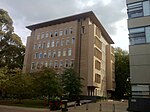Chemistry Building, University of Melbourne
1938 establishments in AustraliaBuildings and structures completed in 1938Heritage-listed buildings in MelbourneNational Trust of AustraliaUniversity of Melbourne buildings ... and 2 more
Use Australian English from December 2019Vague or ambiguous time from January 2015

The Chemistry Building is a university teaching facility used by the University's School of Chemistry, located at Masson Road, The University of Melbourne, Parkville Campus, Melbourne, Victoria, Australia. The building was designed by Percy Edgar Everett, who at the time was employed by the Victorian Public Works Department. It was built in 1938 at a time of major expansion at the University through the 1920s and 1930s. The building is best described as a modernist, inter-war, gothic architecture, and due to this it has been deemed to be of state historical and architectural significance on the National Trust register.
Excerpt from the Wikipedia article Chemistry Building, University of Melbourne (License: CC BY-SA 3.0, Authors, Images).Chemistry Building, University of Melbourne
Tin Alley, Melbourne Parkville
Geographical coordinates (GPS) Address Nearby Places Show on map
Geographical coordinates (GPS)
| Latitude | Longitude |
|---|---|
| N -37.798055555556 ° | E 144.96194444444 ° |
Address
University of Melbourne (Melbourne University)
Tin Alley
3010 Melbourne, Parkville
Victoria, Australia
Open on Google Maps






